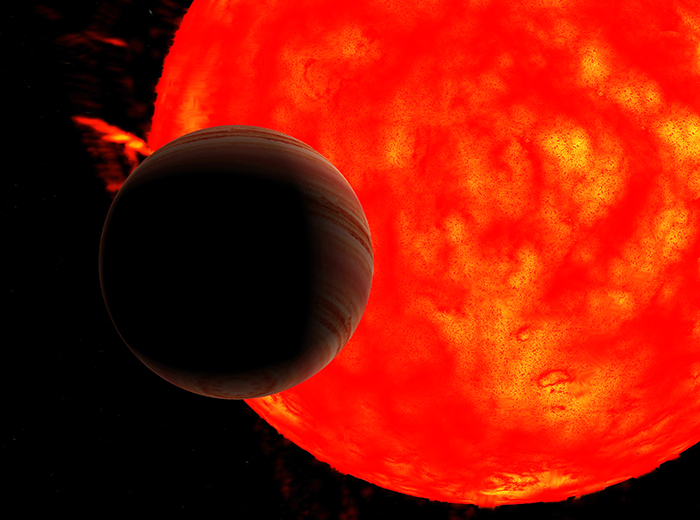The stars closest to the Sun constitute the Alpha Centauri triple star system. In 2016, astronomers used ESO's telescopes and other infrastructure to find clear evidence of a planet orbiting the system's closest star to Earth, Proxima Centauri.
Now, a planet orbiting the Star of Barnard, a mere 6 light-years away from Earth has been detected. This discovery — announced in an article published in the journal Nature — is the result of the Red Spots and CARMENES campaigns, whose search for nearby rocky planets has already revealed a new world in orbit of our closest neighbor, Proxima Centauri.
The planet, designated Barnard's Star b, is the second closest known exoplanet to Earth. The planet is just over 4 light years away from Earth and was discovered by a team led by Guillem Anglada-Escudé. The data collected indicate that the planet may be a super-Earth, with a mass of at least 3,2 times the mass of the Earth, and that it orbits its host star with a period of about 233 days.
Barnard's Star is a red dwarf, that is, a low-mass, cold star that does not illuminate the now-discovered world. Starlight gives your planet only 2% of the energy the Earth receives from the Sun.
Despite being relatively close to its parent star — at a distance of only 0,4 times the distance between Earth and the Sun — the exoplanet lies close to the snow line, the region where volatile compounds such as water , can condense on solid ice. This bleak, bleak world can have a temperature of -170°C, which would make it hostile to life as we know it.

Taking its name from the astronomer EE Barnard, the Barnard Star is the closest individual star to the Sun. Although the star itself is old — it will probably be twice the age of the Sun — and relatively inactive, it is actually the star with the fastest apparent movement in the entire night sky.
Super-Earths are the most common type of planet that forms around small-mass stars like Barnard's Star, which lends credibility to the newly discovered planet candidate. Additionally, current theories of planetary formation predict that the snowline is the ideal location for the formation of such planets.
Previous searches for a planet around Barnard's Star have yielded disappointing results — this discovery was now possible only because measurements from several high-precision instruments mounted on telescopes around the world were combined.
The infrastructures used in this work were: HARPS mounted on ESO's 3,6-metre telescope; the UVES mounted on the ESO VLT; the HARPS-N mounted on the Telescopio Nazionale Galileo; the HIRES installed on the 10 meter Keck telescope; the PFS installed on Carnegie's Magellan 6.5-m telescope; the APF mounted on the Lick Observatory's 2,4m telescope; and CARMENES placed at the Calar Alto Observatory. Additionally, observations were made with the 90 cm telescope installed at the Sierra Nevada Observatory, the 40 cm robotic telescope placed at the SPACEOBS observatory, and the 80 cm Joan Oró Telescope at the Montsec Astronomical Observatory (OAdM).
“After careful analysis, we are 99% confident that the planet is real”, says the lead scientist of the team, Ignasi Ribas (Institute of Space Studies of Catalonia and Institute of Space Sciences, CSIC, Spain). "However, we will continue to observe this fast-moving star to rule out possible, but unlikely, natural variations in stellar brightness that could be mistaken for a planet."
Among the instruments used are ESO's famous planet hunters, HARPS and UVES spectrographs. “HARPS played a vital role in this project. We combined archival data from other teams with new Barnard Star measurements taken by different infrastructures,” commented Guillem Anglada-Escudé (Queen Mary University of London), scientist who co-led the team. “The combination of instruments was crucial for us to verify our result”.
Astronomers used the Doppler effect to find the exoplanet candidate. As the planet orbits the star, its gravitational pull causes the star to wobble slightly. When the star moves away from Earth, its spectrum shifts to red, that is, it shifts to the highest wavelengths. Likewise, when the star approaches Earth, its light is deflected to the smaller, bluer wavelengths.
Astronomers thus use this effect to measure, with extraordinary accuracy, variations in the star's speed due to the existence of a planet in its orbit. HARPS can detect variations in a star's speed as small as 3,5 km/hour — which is equivalent to a person's stride speed. This way of looking for exoplanets is known as the radial velocity method and, until now, it has never been used to detect a super-Earth-type exoplanet in such an extensive orbit around its star.
“We used observations from seven different instruments, corresponding to 20 years of measurements, making this the largest and most extensive database ever used in the study of very precise radial velocities”, explains Ribas. Combining all the data led to 771 measurements in total — an enormous amount of information!».
“We worked hard to reach this result”, concludes Anglada-Escudé. “This discovery is the result of an extensive collaboration carried out within the scope of the Red Spots project, which included contributions from teams from all over the world. We are already carrying out follow-up observations in several observatories'.
Author European Southern Observatory (ESO)
Science in the Regional Press – Ciência Viva



















Comments